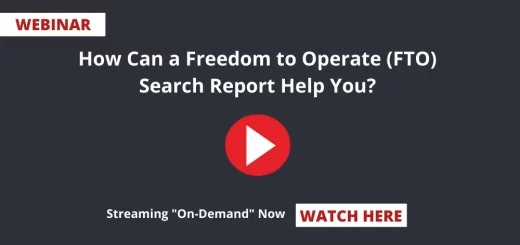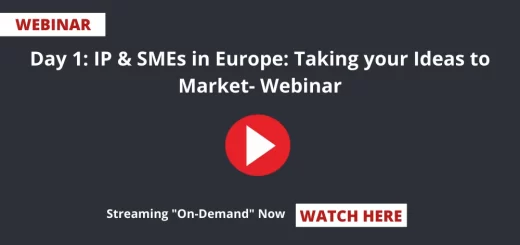Patent Proofreading Advantages – Pains and Perils of NOT Doing Proofreading – Webinar
Patent Proofreading Advantages – Pains and Perils of NOT Doing Proofreading
Table of Contents
Key Points Covered in the Webinar Session
- What is Patent Proofreading?
- Elements of Patent Proofreading.
- Benefits of Patent Proofreading.
- US Patent Proofreading – with the USPTO best practices.
- Amendments, incorporations, grammatical mistakes, bibliography details, eye-for-detail – all covered under Patent Proofreading.
Speakers
Melvyn Thomas, Head – Online Sales Channel, Sagacious IP
Prateek Mohunta, COO, Sagacious IP
Sameer Kumar, Senior Manager, Sagacious IP
Submit Your Information to watch the Webinar Video:
"*" indicates required fields
More details about this webinar:
A successful patent application grant depends on how you draft the patent specification. It should be professional and precise. However, to err is human, and that might result in rejection of patent applications or unnecessary office actions. You could have avoided that.
According to recent research conducted on a sample of 1600 patents issued by the USPTO:
- 98% were incorrect
- At least 1 PTO mistake was found in every US patent and more than 3% needed a correction certificate.
- Approximately 2% of the patents had serious mistakes that were enough to ruin the original claims.
Patent Proofreading helps avoid such errors and can save patent prosecutors a lot of trouble.
Webinar Transcript:
Melvyn Thomas Speaking – Welcome everyone to the webinar! This is Melvyn Thomas, head sales online channel at Sagacious IP, welcoming you all to our webinar today on the topic Patent Proofreading Advantages – Pains and Perils of NOT Doing Proofreading.
I hope you, your friends, family, and colleagues are well in the current virus pandemic situation, and we, on behalf of Sagacious IP, wish for the best of their health. Before I go on to introduce the topic of today’s webinar and the esteemed speakers on our session, I am delighted to welcome all the participants from different countries like US, Canada, India, UK, China, Poland, Korea, Russia, and several other countries from different parts of the world, and like we always say your participation is a wonderful encouragement to the efforts and the attempt that we are making to raise awareness and spread knowledge that has been honed by Sagacious IP over several years of working with inventors, R&D organizations, IP departments, and IP law practice practices.
Our first speaker of the session is Prateek Mohunta. He is the COO of Sagacious IP which is a 350 plus patent IP professionals company in the business of Patent Searching, Drafting, Licensing, Paralegal, and other support services for over 14 years now, and, he, Prateek, is a textile engineer from Indian Institute of Technology in Delhi. He is seasoned IP professional, advising R&D managers, IP attorneys, and licensing managers for over a decade now.
Welcome to the webinar, Prateek!
Prateek Mohunta Speaking – Yeah, hey Melvyn! Thank you very much for having me on the webinar. It’s a pleasure to be here.
Melvyn Thomas Speaking – Great!
Our second speaker is Sameer Kumar. Sameer is a senior manager, intellectual property management system at Sagacious IP. Sameer has over 10 years of experience in ITES, LPO, and KPO industry with the domain expertise in Indian, U.S., EP patent application filing, IP paralegal, and patent support services. In fact, Sameer was one of the first paralegal analysts in India and has been instrumental in setting up a lot of processes that we see now being used in the industry.
Welcome to the webinar, Sameer!
Sameer Kumar Speaking – Thank you very much for having me on the webinar.
Melvyn Thomas Speaking – Thanks for joining, Sameer. Before we start off with the presentation today. Let me ask our speakers for their initial remarks on the topic “Patent Proofreading Advantages – Pains and Perils of NOT Doing Proofreading.” What are the patent proofreading advantages? Why do you require it? What is the purpose behind it? How does it actually work? And how does the proofreading patents get executed to get 100% Patent Proofreading Advantages? So, let’s start with Prateek.
Initial Remarks on Patent Proofreading Advantages
Prateek Mohunta Speaking – Thanks Melvyn for that introduction and thank you for introducing the topic here. It’s nice actually to talk about a topic like patent proofreading advantages, and it’s good that we are getting this opportunity to set that context and pass on this knowledge and awareness that we have about this to multiple people attending here.
The importance of correct patent specifications cannot really be overemphasized. The scope of the finally granted patent depends on the specification as it actually enables the claim and the invention that’s contained therein. Mistakes during the process of patent drafting are normal. It happens. It’s human to make an error, but mistakes while drafting the specification or even when the patent gets granted because of the multiple interactions that we have with the patent office, there are major chances that errors may creep in.
It’s important that a patent is proofread, because otherwise, the final specifications, if there are mistakes, won’t really serve the purpose, and worst comes to worst the invention would then be in the public domain, and nothing would be possible, then, to patent that invention again – a patent that is disclosed. But the good thing is that it’s easy to resolve this, and the step of patent proofreading gets overlooked very often.
We’re just here to raise awareness about patent proofreading advantages and help everyone understand how a very small step in this entire process can go a long way in ensuring that the patent you get provides the protection that you deserve.
Melvyn Thomas Speaking – Yeah, thanks a lot! Okay, so, let me, now, ask Sameer to share his initial remarks on this topic.
Sameer Kumar Speaking – Yeah! Thank you, Melvyn!
As Prateek mentioned, in our engagement with customers and the IP community in general, over the past twelve years, we have witnessed how patent proofreading has helped avoid error, incorrect claim construction, grammar, enablement, and even technical impact. With the right information, we can transform the way this process works, and through this webinar, we will like to inform and make every patent owner aware about the importance of this step and also at the same time how easy it is.
Melvyn Thomas Speaking – Absolutely, I second your thought there. Thanks a lot, both of you for setting up the context for this webinar. Let us now begin with the main part of the presentation, and for that, let me invite Prateek to take us through and help us understand Patent Proofreading Advantages – Pains and Perils of NOT Doing Proofreading.
So, over to you Prateek!
Introduction to Patent Proofreading Advantages – Pains and Perils of NOT Doing Proofreading
Prateek Mohunta Speaking – Perfect! Thanks! Thanks, Melvyn, and without taking any more time, I think we could start off setting up the context behind it, and I’ll just quickly run through certain statistics number that we might all be very familiar with. As Melvyn mentioned, I’m happy that there are people from all around the world here, but the webinar or the data that we’ll be presenting would be more focused or towards the USPTO, and the processes there, but it’s the same process that can also be applied to other patent offices with certain changes. So, yeah, moving ahead now!
Errors in Patent Applications
Approximately 600,000 patents are filed at the USPTO each year on an average. Out of which about three hundred fifty four thousand patents were issued in 2019, and that’s an increase of about 34% in the last ten years – a cumulative increase of about 34% in the last ten years. Average pendency is about three years for a patent, so that’s good to know that the patents are actually getting granted faster, but if you go by an analysis that was done a few years back, there is a link at the bottom with some sample analysis of a few issued patents at the USPTO.
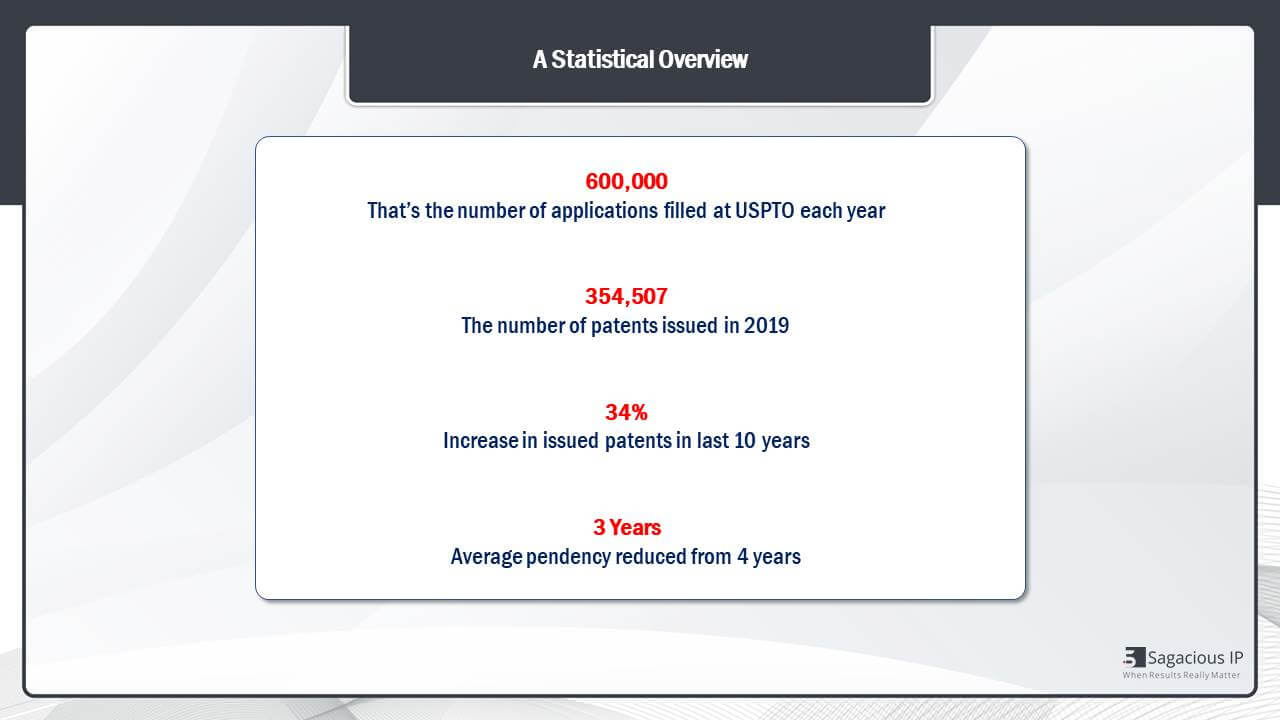
Almost 98% of US patent had at least one mistake in them. They looked at about 2000 odd US patents, and they found that at least one mistake was there in 98% of those patents, and over 50% of the mistakes were made by the USPTO during the prosecution stage, and because there is a lot of amendments that go in there, there is a lot of communication that happens, ideas get submitted, assignment recorders happen, priority information gets updated, and priority documents get submitted. There is a lot of information transaction that happens and that’s where the errors often creep in and so 50% of them were made by the USPTO and the rest was from the applicants end.
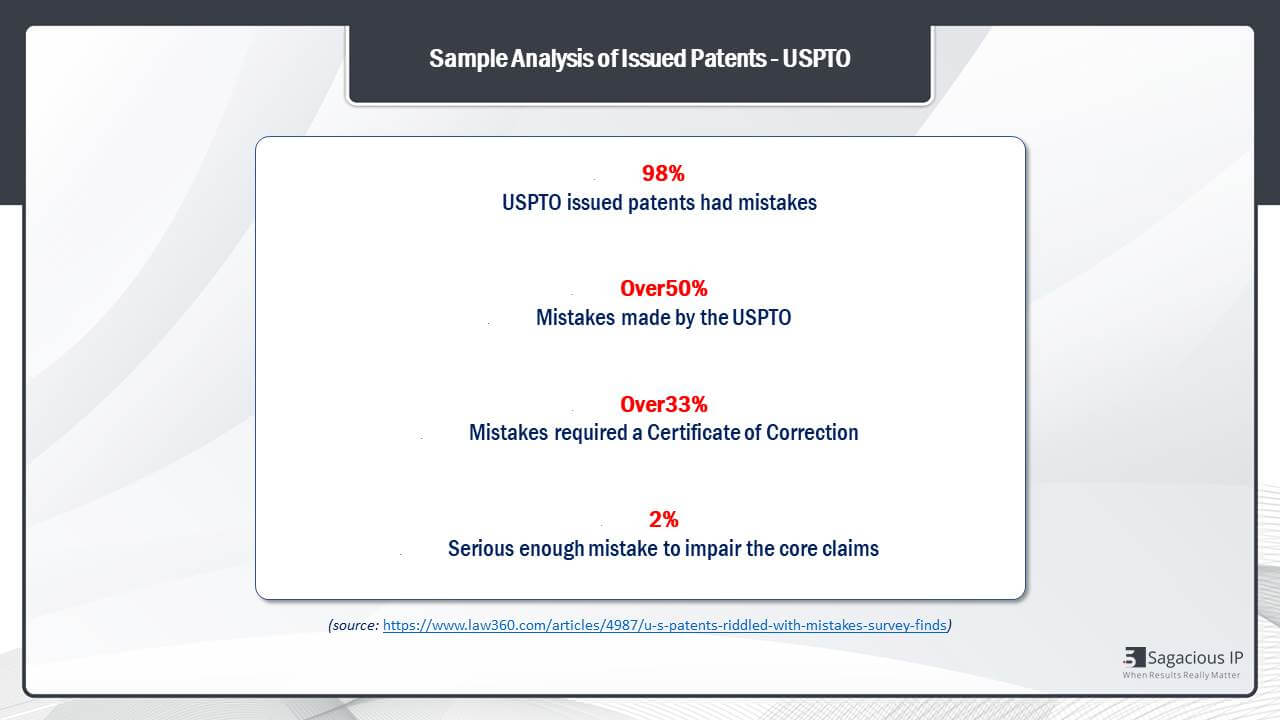
Certificate of Correction
Over 33% of these mistakes require a certificate of correction. We will further discuss on this as we move forward on the webinar, but this is sort of gives you an idea of how many errors there are and how many actually major errors are that require submission of a certificate of correction, and 2% of mistakes were serious enough to cause problems with the claims that were filed. They would have impacted the claims that were there, they would have impacted the scope of the claims, and they would have possibly impacted the enablement of the claims. Those are the numbers that we’re talking about.
If you’re a person or if you’re an attorney who maybe ends up filing 100 patents a year or maybe 50 patents a year, so on an average, that would mean that you’re looking at least two patent or one patent that has an error which is really serious, and if not taken care of, could lead to problems as we move forward.
That’s about setting the context just to know why this is important and how these errors can actually cause real problems. Let’s just take a quick look at what kind of errors there are. Sometimes, we overlook them, and sometimes, they’re really difficult to track, but, let’s just take a quick look at those.
Perils of NOT Proofreading Patents
Peril 1: Limited Scope of Patent
This is the first, as to say that, problem that we are looking at in terms of not proofreading patents. If you would look at the left, it’s a standard notice of allowance that we get from the USPTO, and if you see the allowed claims are from 1 to 18, but if you look on the right, the actually issued patent, it only has claim number 1, and you have got 17 claims missing from the issued document. Now, this sort of defeats the purpose of the entire process, and if you don’t proofread it even after getting the notice of allowance, this could actually cause issues as we move forward.
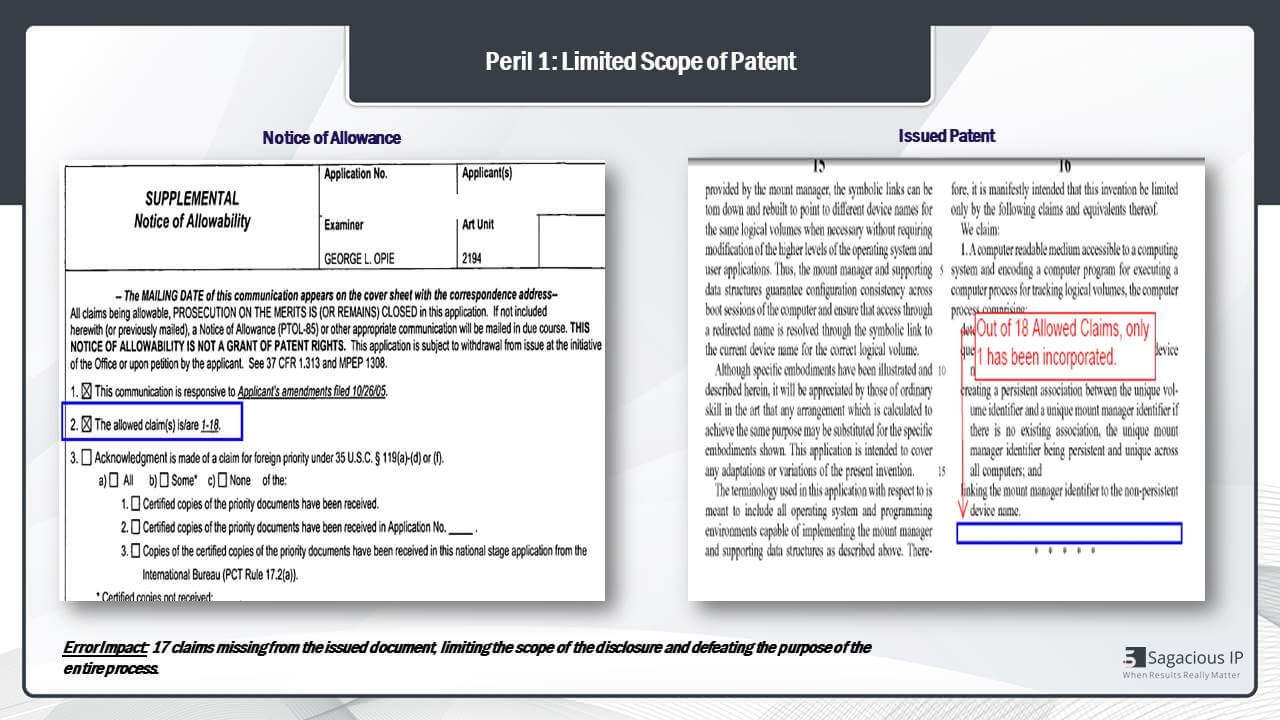
It sort of limits the scope of your disclosure. All your creams are gone. This may be a major problem and major scenario where you see such an issue exists, but there are also smaller problems that could be there where a particular claim might be missing. Two or more claims might be missing. This is an example of a problem that could be there if not proofread properly.
Peril 2: High Risk of Invalidation
If you look at the left here on the originally filed document, the priority is claimed from a U.S. provisional application, whereas, in the issued patent, the provisional application, the priority information is missing. Now, this is really important, because we have seen in the past where a third party has initiated invalidation on such scenarios. There are cases where this has happened in the past. This is something that you really need to take care of, and this is again a small problem, small error that can be very easily rectified using quick proofread of the patent which is being issued.
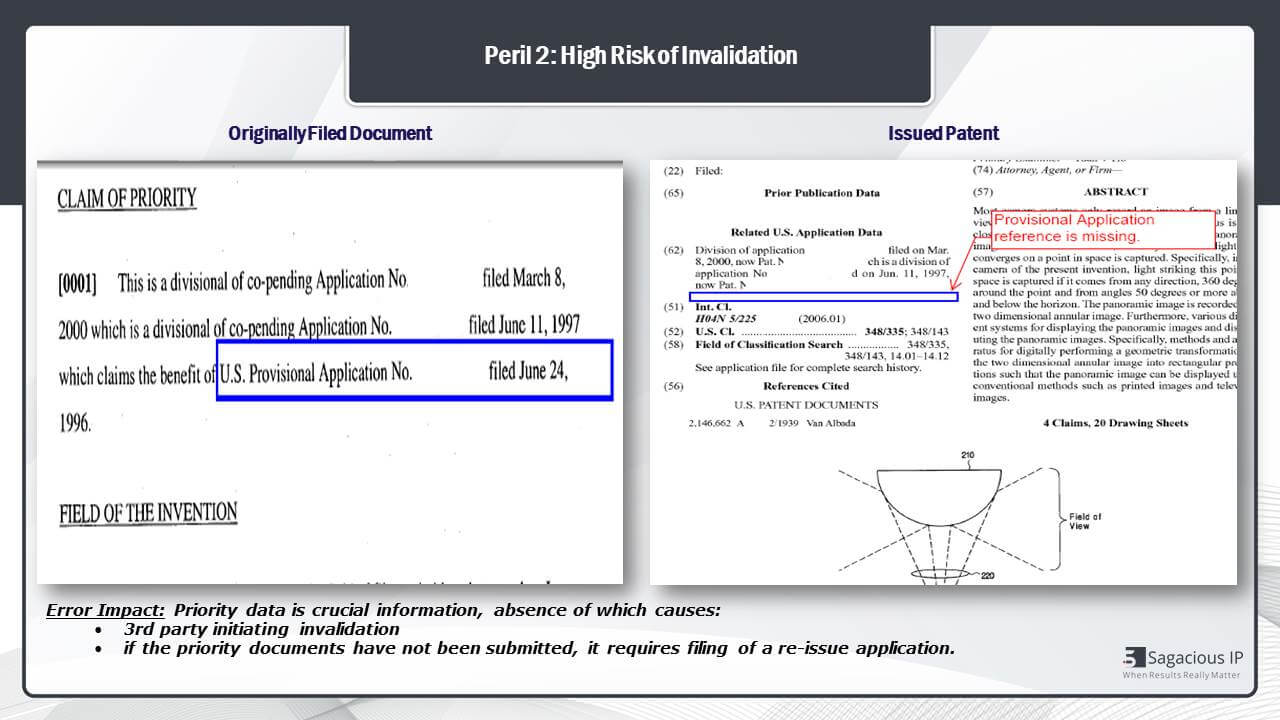
Through these slides, all we wanting to do here and all we wanting to show here is the kind of errors that exist and the kind of errors that creep in during the entire process, and the errors that you see here, they would seem so very simple and so very easy to identify. I tell you that these are the bigger ones that we have sort of from our experience in the past. The bigger ones that we have identified and shortlisted are shown here, but they are even smaller errors which are there and which can cause problems.
Peril 3: Opening Door to Re-examinations
For example, in this one, the applicant had actually submitted eight references in the ideas, but eight of them are missing in the finally issued document and if the examiner had not even considered that, then this could be an open and window for ex parte re-examination or invalidation proceedings in the future. Even things like that could be important.
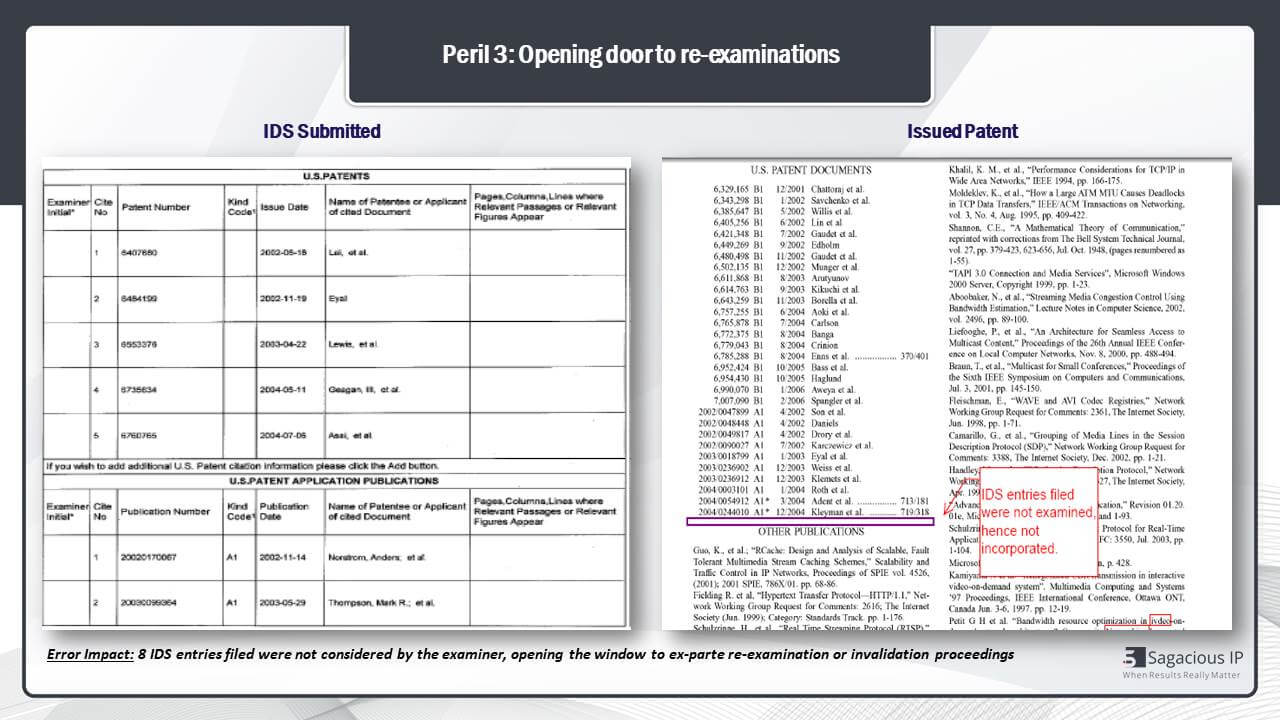
Peril 4: Change in Scope of Claims
Another error or another problem, if you do not proofread a patent, is related to claim elements not being defined correctly or there is ambiguity in defining of claim elements.
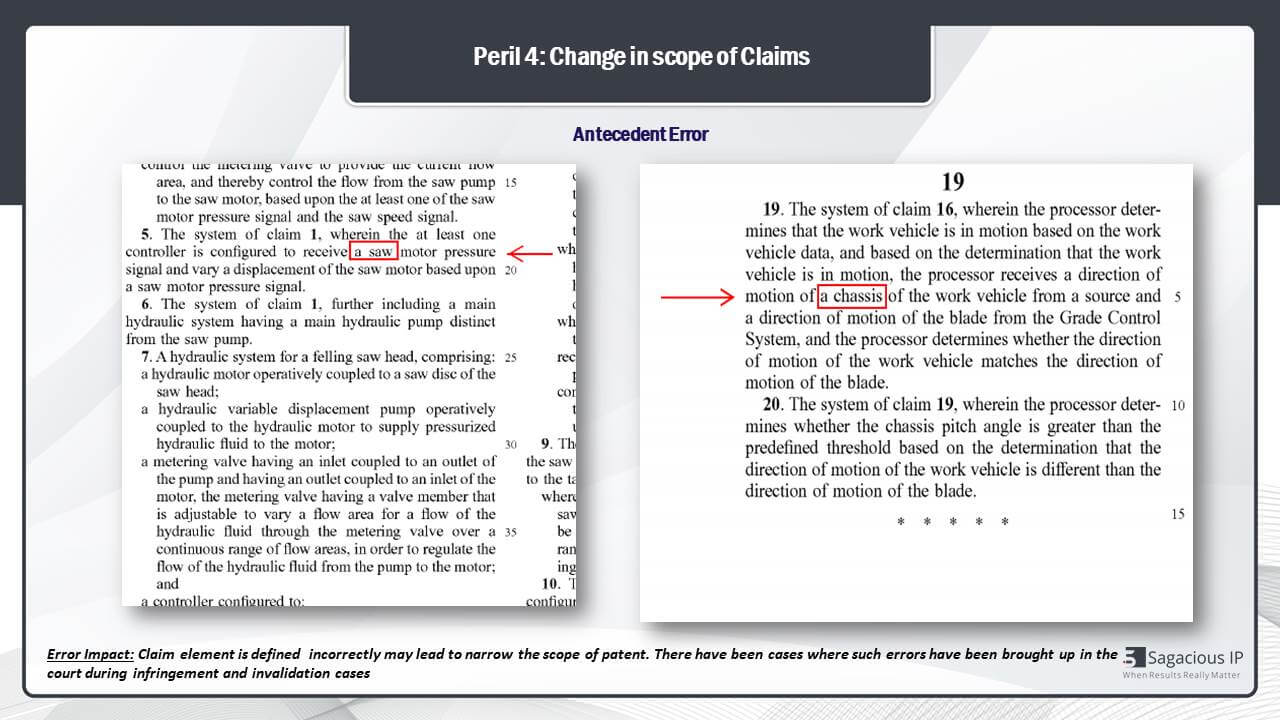
For example, if you see on the left and if you see on the right, these are issued patents where you have antecedent error where a saw motor is being introduced again, whereas it had already been introduced earlier. Things like that have happened. I actually remember a case. Actually, I think it was back in early 2010 or maybe at the end of the last decade. I think it was something to do with account management where this particular scenario was brought up in the course during a patent litigation proceeding, and the court had taken a very adverse position on the patent that was granted, and all the errors were related to antecedent basis, and it was really embarrassing for the law firm which was there, which was involved and it would have really been saved very easily if proper proofreading patents had been carried out.
Peril 5: Possibility of Invalidation
Similarly, other errors that sort of creep in are simple grammatical errors or simple spelling or consistency in the terms that are being used. If you see on the left, it’s called saw motor in the claim, whereas in the specification, it becomes a saw moor.
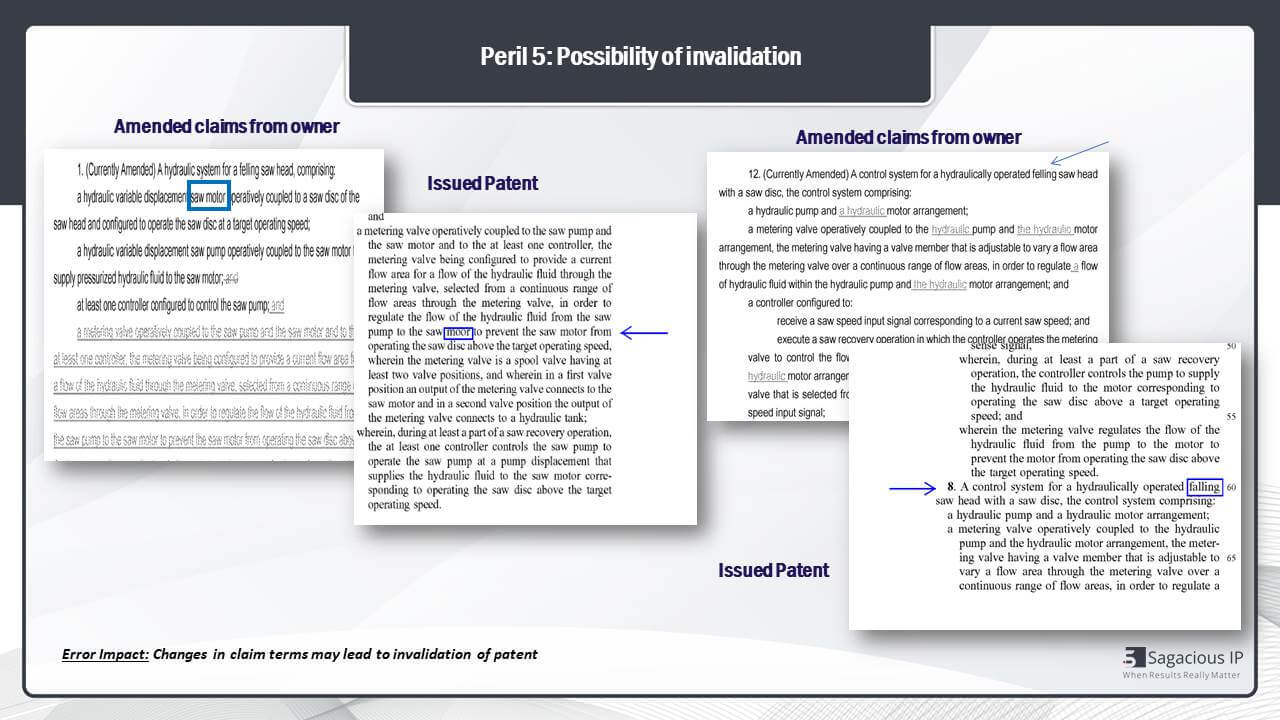
If you see on the left you know a saw motor has become a saw moor, and, on the right, the same problem with the term being used in different sections of the patent application. There is no consistency in the claim terms which could possibly lead to invalidation.
Peril 6: Possibility of Post-Grant Opposition is High
Again, these were simple amendments that were done by the applicant. On the left, you can see the term arm has been struck out, whereas, in the issued patent, the support arm member is still in there and has not been properly incorporated in the issued patent which could again lead to change in the actual interpretation of the claim, and the claim being open to future oppositions and future invalidation just because of this.
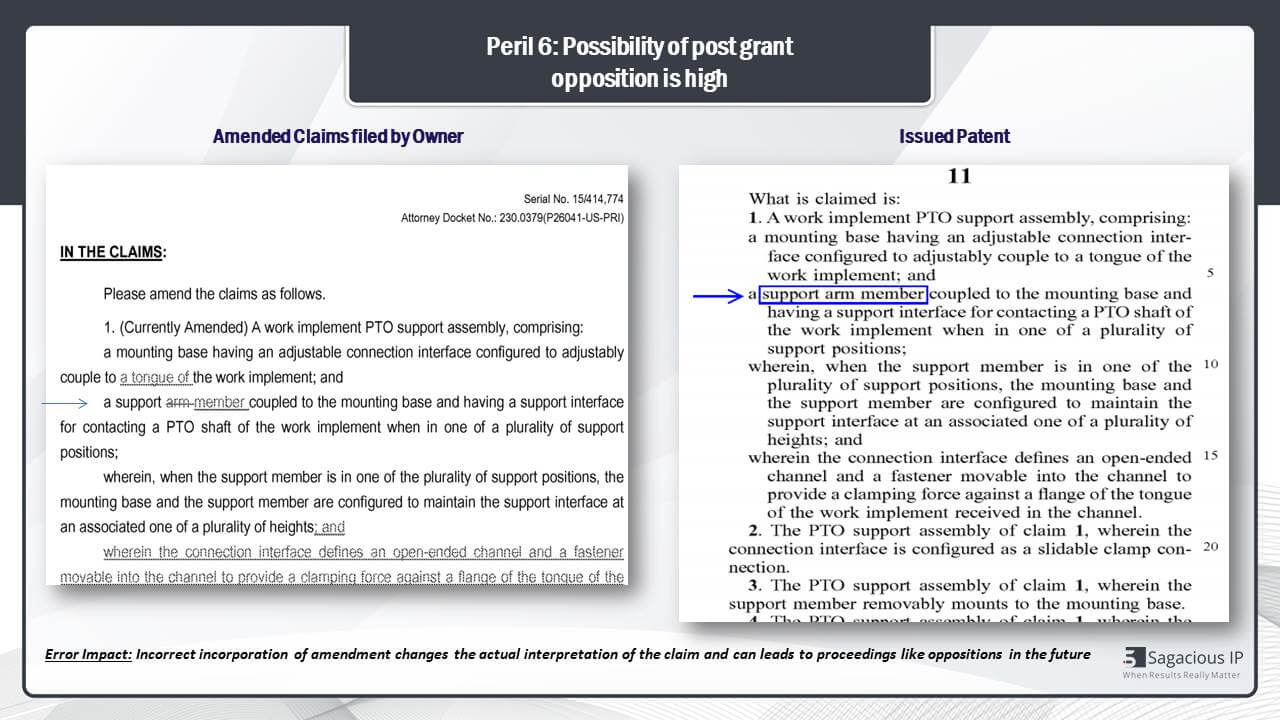
So, it sort of reduces your scope. It reduces the way your patent covers the invention that you want to cover and could cause serious problems as we move on to the later stages. We just wanted to highlight a few problems that exist and a few problems that creep in, and the next part of the presentation would be handled by Sameer and would be primarily about how the patent proofreading works, what are the steps involved, and how easy it is to take care of such things.
What Do We Do while Proofreading Patents?
Sameer Kumar Speaking – Thank you Prateek!
As we have seen what different types of errors can occur in a granted patent of the USPTO, now it comes to what we basically do in patent proofreading. Once a patent is granted, client generally sends us a granted number that is patent number, and in the next slide, you will see the first page.
Face Page Review
Yes, so, in this slide, you will see that the first page of a granted patent would certainly will look like the same, and, on the top, at the “10” number, you will see the patent number, the date of the patent, and, on the right hand side, you will see that there are some numbers mentioned.
These numbers are known as INID code that is International Identification Code. These codes are more or less or almost similar for entire globe’s patent, like, for example, if you see that 65, 65 will always be a prior publication data.
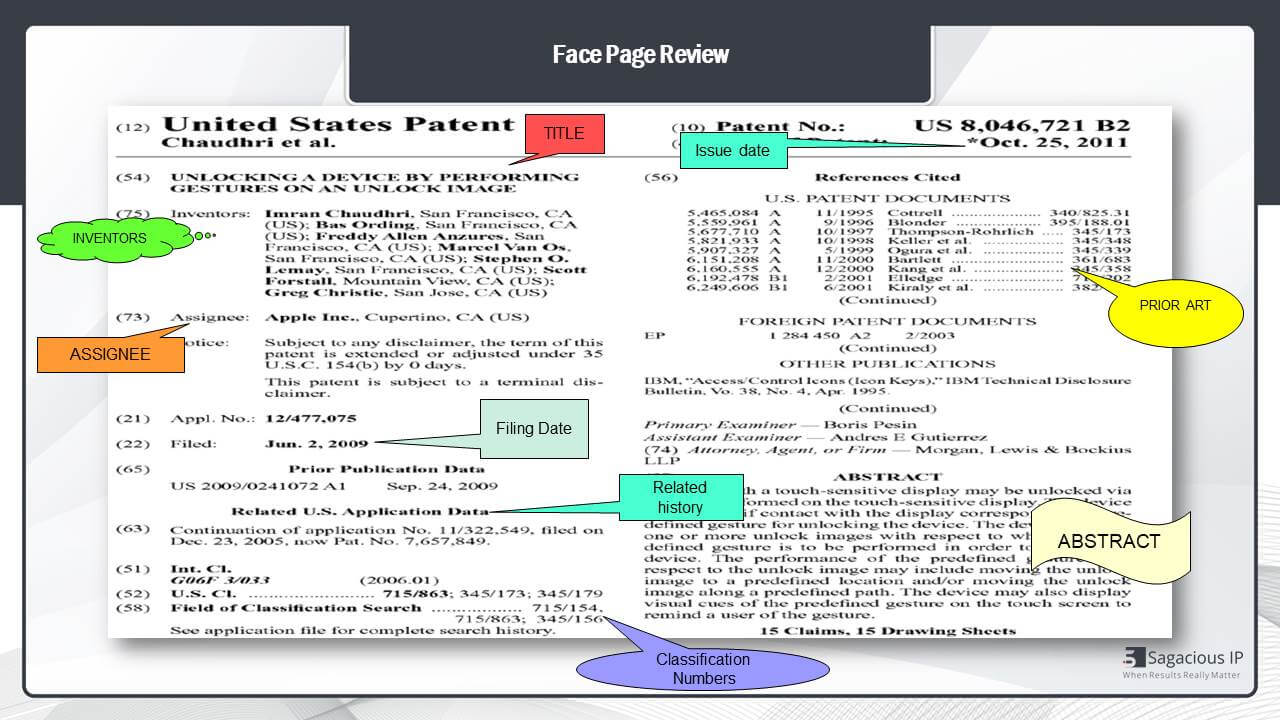
So, this 65, sometimes, what happens that how patent office would know that what patent application or what is the publication number of this patent. And, that publication number will always come again 65 number. Most of the time, we have noticed that this 65 number would be wrongly printed on the granted patent, and so, this is a major error on the first page of the granted patent.
So, these things once a proofreader, who is proofreading a patent, he or she should be aware of what International Identification Code signifies against each number.
So, this is the first page, and if you see the 75 number, it details about the inventors, their country, their city, the 73 number is assignee.
So, these are the first page number, and at this point, at the time of application filing, every Patent Office has a certain law according to which you have to file certain forms and that form should be on the basis of type of application. Suppose that it’s a provisional application, then ABC form would be required, and once you are converting that provisional application into a non-provisional one, then some different forms would be required. Based on those forms what information you have provided in those forms, this entire first page would be printed
So, you as an applicant have provided correct information. At the time of printing of this granted patent, let’s say that the USPTO has done a mistake. and then some information would be misspelled or wrongly typed, then that needs to be corrected and that correction would be done on the basis of the forms you have filed, right? So, this is what the entire first page we proofread.
Drawing Review
So, over to the next page, yes, this is a drawing, and as we all know that patent drawings, specification, and claims, these three things are the important components of any patent application when we file. So, certainly, drawing would be examined and whatever drawing has been approved by the examiner, that thing has been incorporated in the granted patent that you have to ensure.
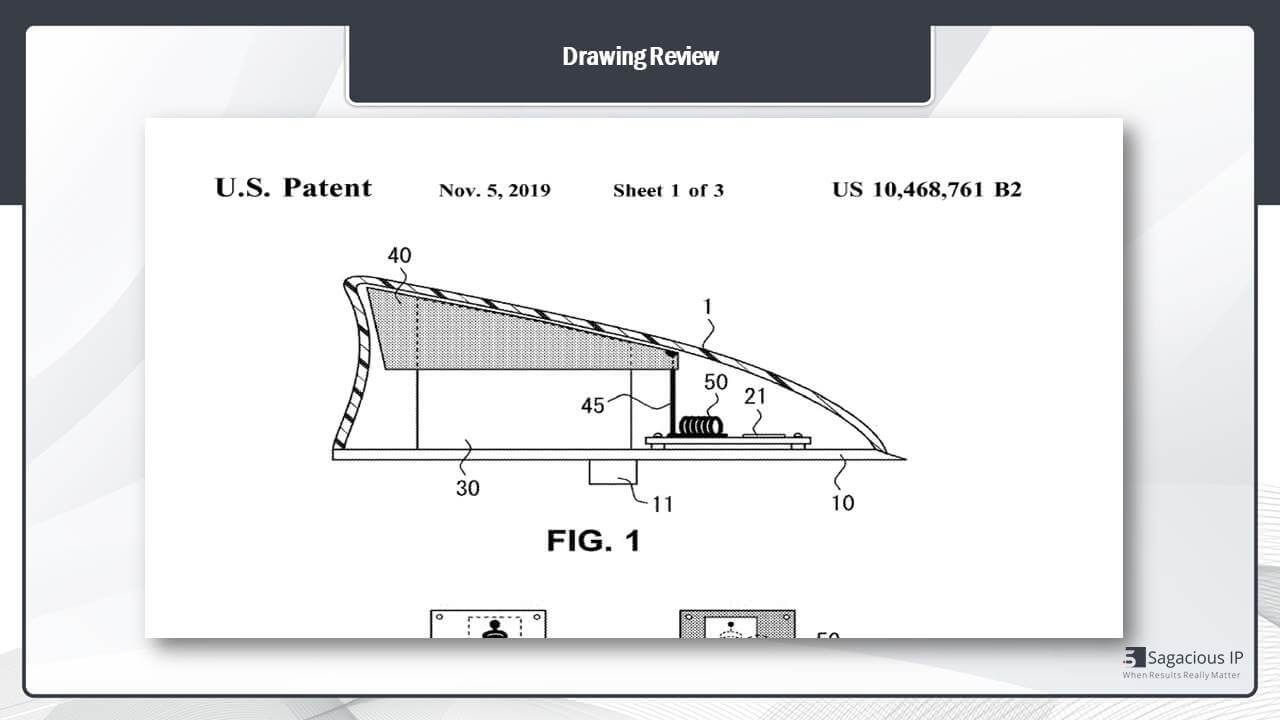
In each drawing, you will see that reference numerals. You should incorporate these These reference numerals should be correctly incorporated in the granted patent. So, this is how we proofread the drawing. So, each and every drawing like, for example, the USPTO has certain norms that the page should be marked as Sheet 1 of 3 or figure should be marked as FIG dot One. Suppose that you have written entire FIGURE. That is incorrect format. The USPTO would not accept that format.
So, suppose that, in a granted patent, entire figure 1 is incorporated or printed, so that is a kind of error in the granted patent under drawing. The same goes with reference numerals. So, suppose that you have indicated forty-five on the top in the place of forty, but in the granted patent, forty-five is appearing at a different place. That is one of the important or major errors under drawing. We proofread patents when we review the drawing, and all patent proofreading would be done against the documents which applicant has filed and approved by the examiner.
Over to the next section! As I mentioned that the three important components would be drawings, specification, and claims, we have seen that how we proofread the drawing.
Specification Review
So, now it comes to the specification. In the specification, as the name, itself, suggests that there should be something in a very elaborative way. So, in the specification, the first thing you have to check, as Prateek mentioned in one of the slide that we checked grammatical mistakes, all punctuation marks, spelling mistakes, and consistency. Everything should be there.
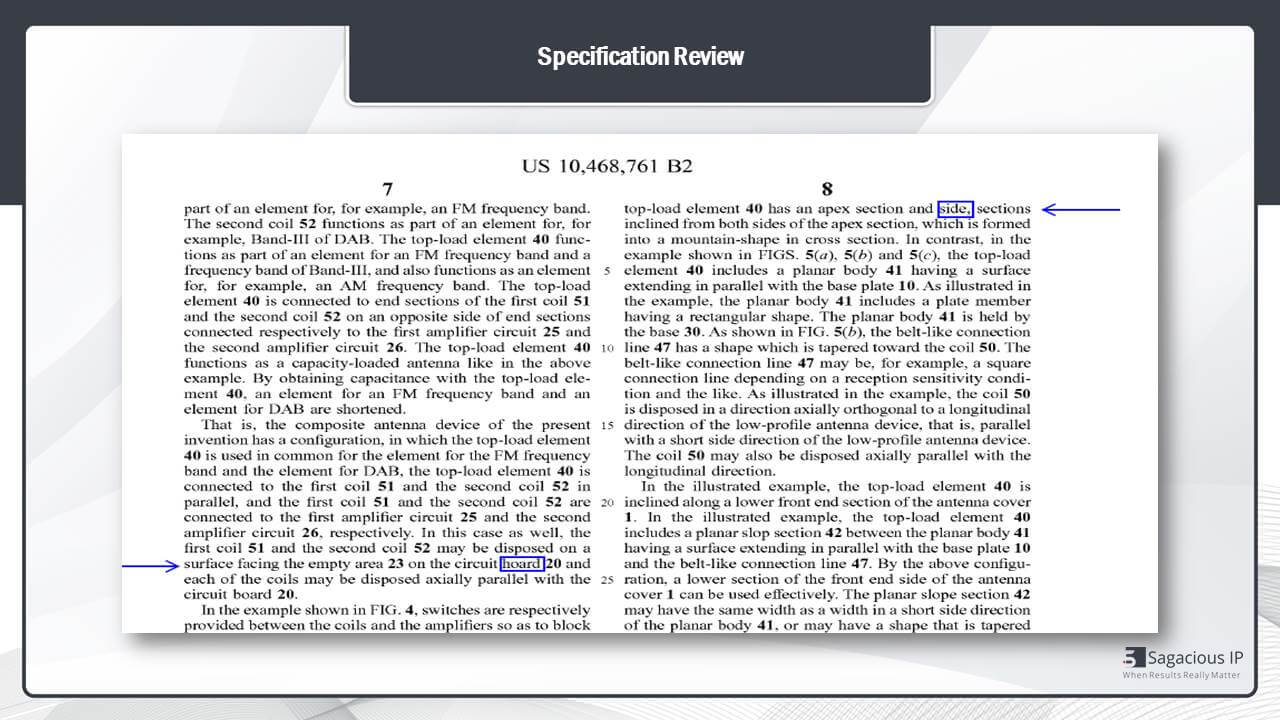
The second thing that the drawings or the drawings which you have filed and approved by the examiner that should be clearly and correctly explained in the specification. In drawing, Prateek, if you go back to the previous slide – on the drawing – yes, if you see that, in this drawing, that reference numerals forty, thirty, and forty-five, these things are explaining certain components, so all these reference numerals should be clearly defined under specification.
We do proofreading patents, and we ensure that entire specification is in line with the drawings which we have filed and approved by the examiner. Plus, there should not be any grammatical mistakes. Suppose that we have some acronyms. Those acronyms should be correctly defined. So, this is how we do patent proofreading of specification.
Claims Review
So, now, over to the next slide that is “Claims”. Though all the sections are equally important, but “Claims” is the section where you are claiming your invention. You are claiming that device. That this is my claim, right?
So, the first thing, you have to check that claim should be dependent and there should be appropriate dependent and independent claims, and it should be as per the USPTO norms.
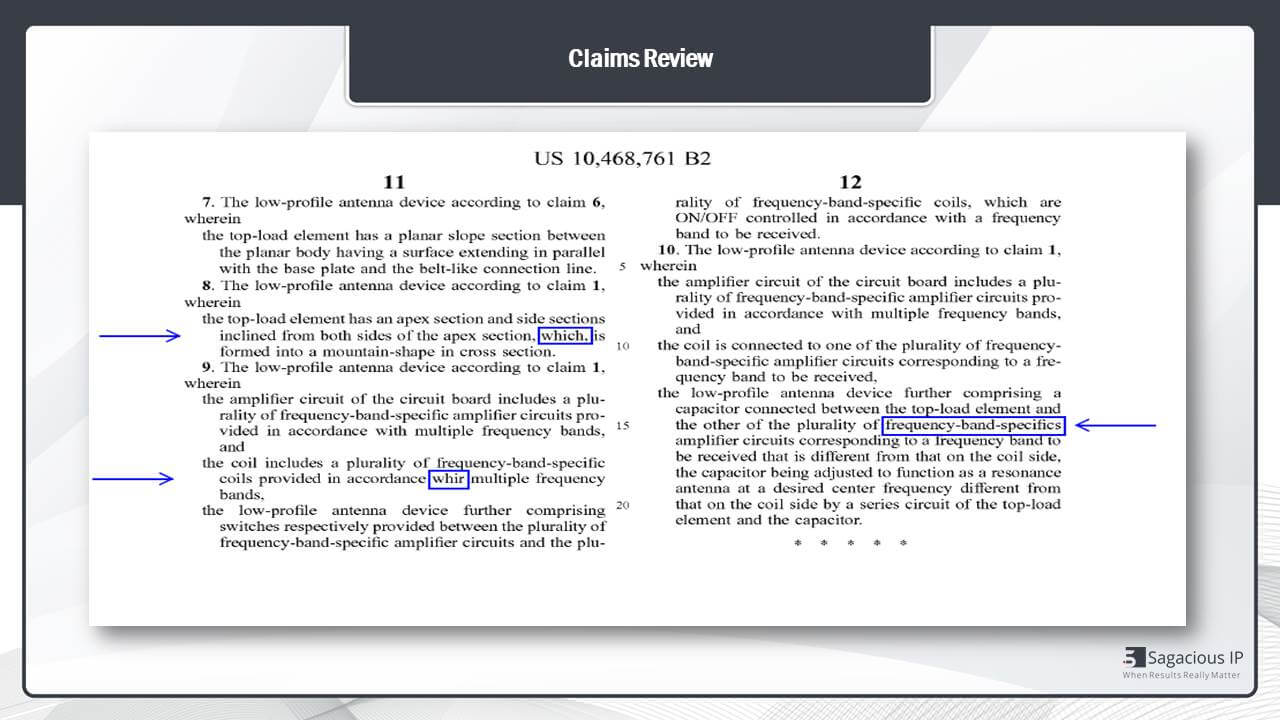
Now, second thing, all independent claims should be correctly defined. Like, for example, generally, we have seen that independent claims starts with “a”. So, these things you have to mention, or you have to check that – is my independent claim starting with “a”?
Now, coming over to the dependent claims!
Again, if my dependent-claim, suppose “claim 2”. “Claim 2” is, certainly, would be dependent on “Claim 1”. It can never be dependent on another claim. Let’s say fifth or sixth. So, here you have to check that – if my dependency of claims has been correctly incorporated in my issued patent.
Again, the antecedent errors which Prateek has explained earlier, so, again, all elements we first by checking the antecedent errors – what we do that we first take out all the elements from independent claims, and we ensure that those elements should not be independently defined in the dependent means.
So, these things we ensure that should be correctly incorporated all amendments. Suppose, at the last moment, sometimes, what happens that after notice of allowance, there is an amendment called 312. Amendment 312 that is always filed after notice of allowance. That amendments majorly filed by the applicant. If applicants think that there is some punctuation or grammatical or some minor error which needs to be corrected, but now we have a notice of allowance I need to correct, then applicant will file those amendment 312 – 318, right?
So, again you have to ensure that whatever amendment applicant has filed where this has been approved by the examiner or not. Once examiner has approved, suppose examiner has strikethrough some certain amendment which we have filed, then we have to ensure that those amendment – those strikethrough lines should not be incorporated in the claims or any of the section where we have filed the amendment.
So, by this way we ensure that everything should be aligned with the applicant’s document plus the examiners amendment, plus as per the USPTO laws, all 37 CFRs, and other USPTO law rules which define a standard utility non-provisional application and it should look like. So, we try to match, and we try to comply with all these requirements while doing patent proofreading.
Proofreading Parameters
Once proofreading is done, then it comes to the proofreading patents parameter, and as I mentioned that, here, we compare whatever document we have filed – we as in applicant has filed, and whatever has been approved by the examiner. For that, you need to go to the USPTO Public Pair. You need to download the image file wrapper along with the amendments and then start comparing everything. So, then, again, check on the page number – page heading – then, ensure that illustrations, captions and labels correspond with each other – then, claims.
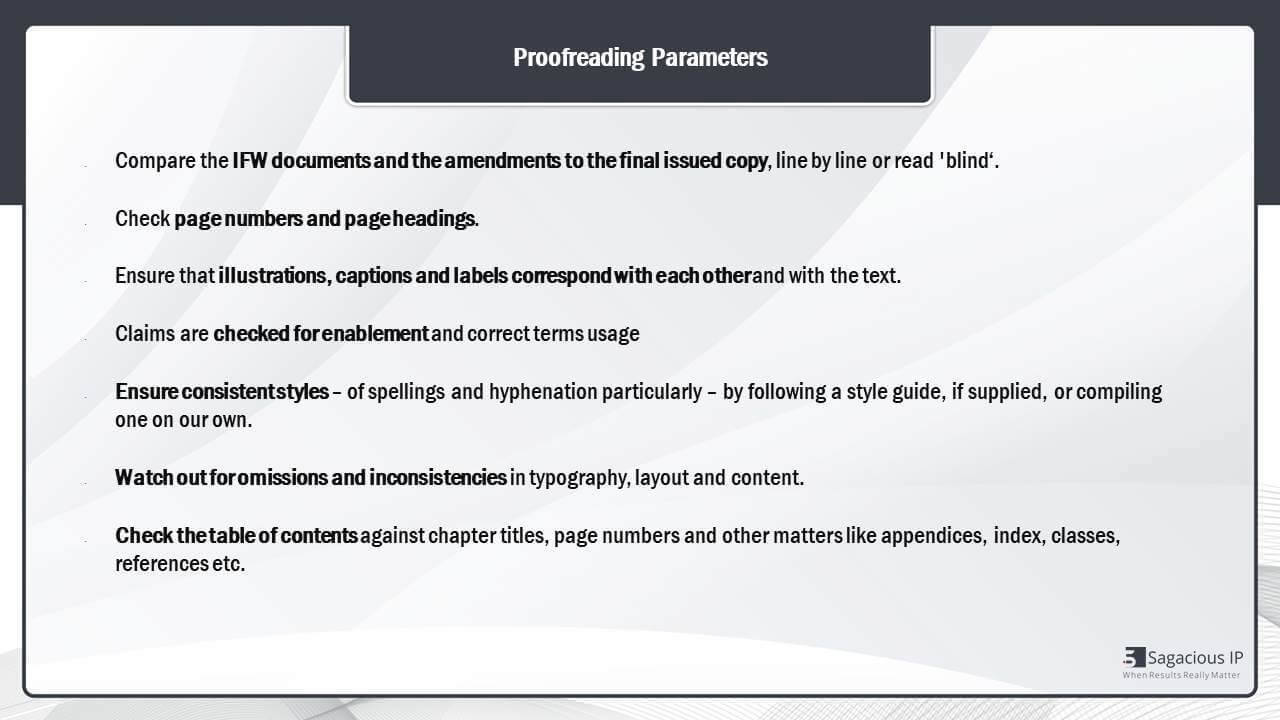
We check everything as I already explained that we check each and every minute aspect of claim – then, consistency and style. Watch out for omission and inconsistency in typographical layout and content, and check the table of content against the chapter, title, page, page numbers, and other matters like appendix in index classes, references, et cetera.
So, these are certain proofreading parameters which we follow to maximize the Patent Proofreading Advantages. As we have mentioned here title, for example, title. The USPTO law says that title should not be more than 150 words. Sometimes, because of ignorance, an applicant files long and lengthy title, and, somehow, it gets approved, but it is applicant’s responsibility to go ahead and get it corrected from the examiner. Otherwise, again, it may create an invalidation procedure by the third party. We should take care of these things during the patent proofreading phase to perils into patent proofreading advantages.
When Should We Do Proofreading to Get Patent Proofreading Advantages?
Over to the next slide!
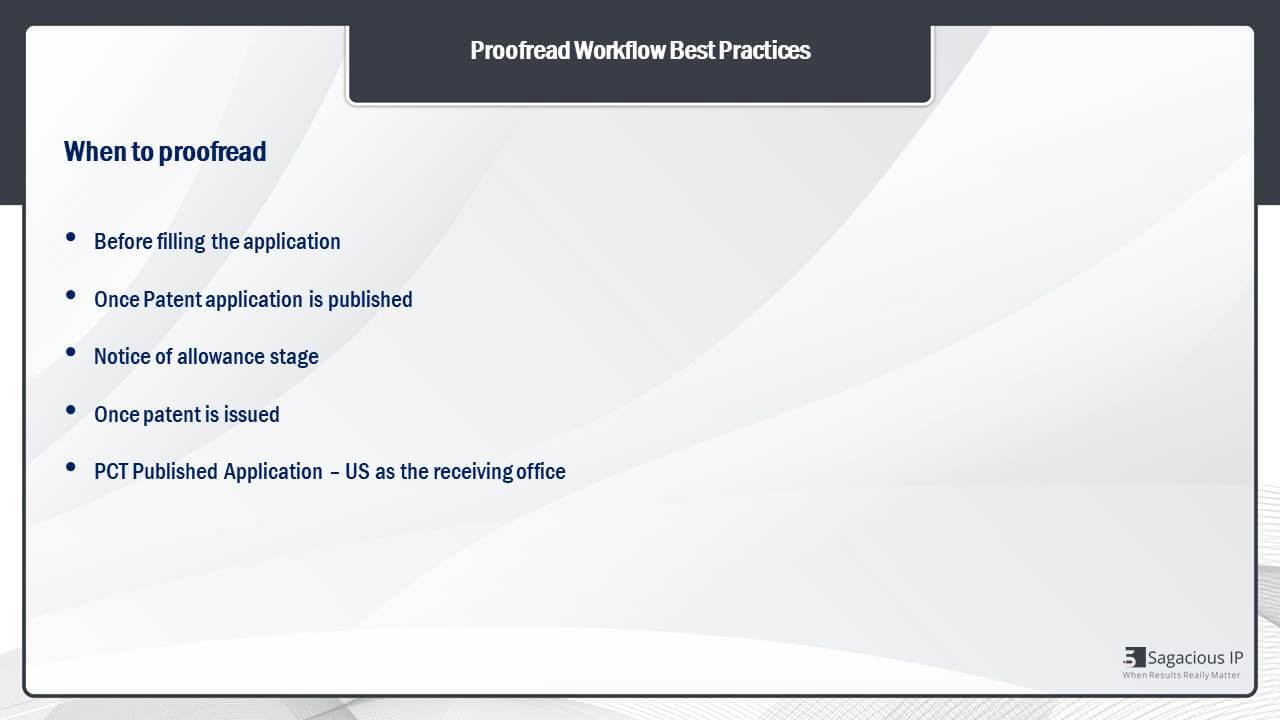
Application Filing Stage
A question comes: when can we do a proofreading? What we, generally, propose to the client is that proofreading patents can be done at multiple stages to obtain patent proofreading advantages. First, we can start with the application filing stage. So, what do we mean by application filing stage that once an inventor or applicant is planning to file an application, the person who has drafted an application – it’s a long 30-40 page application or maybe 20-25 pages application. Certainly, there would be a high possibility of grammatical mistakes, there would be high possibility of any inconsistencies, and there would be high possibility of incorrect claim dependencies.
So, at the time of application filing, we do proofreading patents of all these things. We just get a word copy of application from that client, and then we do proofreading, and we take care of all these parameters. Because of applicant problem or because of applicant’s ignorance, examiners should not issue any office action. So, that is why if we get it corrected at the time of application filing, there are less possibility that examiner will raise certain objection under 102 or 103 that the applicant has not followed the USPTO norms. That is the reason that we always propose that proofreading should be done at the time of application filing to clients so that they don’t miss patent proofreading advantages.
Application Published Stage
Second stage would be that once application is published. So, suppose application is published, and you do not have any opposition, and you want to extend your application beyond your native country. Then, certainly, you do not know – what is the parameter for other country? So, it will be always better that once application is published in US and then get it proofread, so that, at the time of publication, whatever amendments has been done or whatever preliminary amendment the applicant has filed that should be incorporated, so that, in the future, if you extend your application to the different countries, there would be a less possibility that your application get rejected.
Patent Granted Stage
So, it increases chances of issuing office action by other country examiner, and it will be helpful for applicant. Now, at the time of granted stage which we already explained that once patent is granted, then we just asked for a patent number, and then we download that patent and image file wrapper, and from there, we do start proofreading, and at this stage we ensure, again, I would say that we ensure that everything has been incorporated correctly.
PCT Application Stage
Apart from these three stages of the U.S. patent application proofreading, the client also asks us to proofread the PCT application – PCT published application, because after PCT, that application is going to enter into a different national stage. So, certainly, again, just to avoid any issue or just to avoid any rejection from respective national stage’s country’s examiner, the client asks us to go ahead, and do the proofreading of the PCT application.
Now, over to next slide!
And, this is how we do proofreading. That entire methodology we follow while proofreading patents to increase patent proofreading advantages, and in that methodology, first, we receive request from the client to go ahead and do the proofreading.
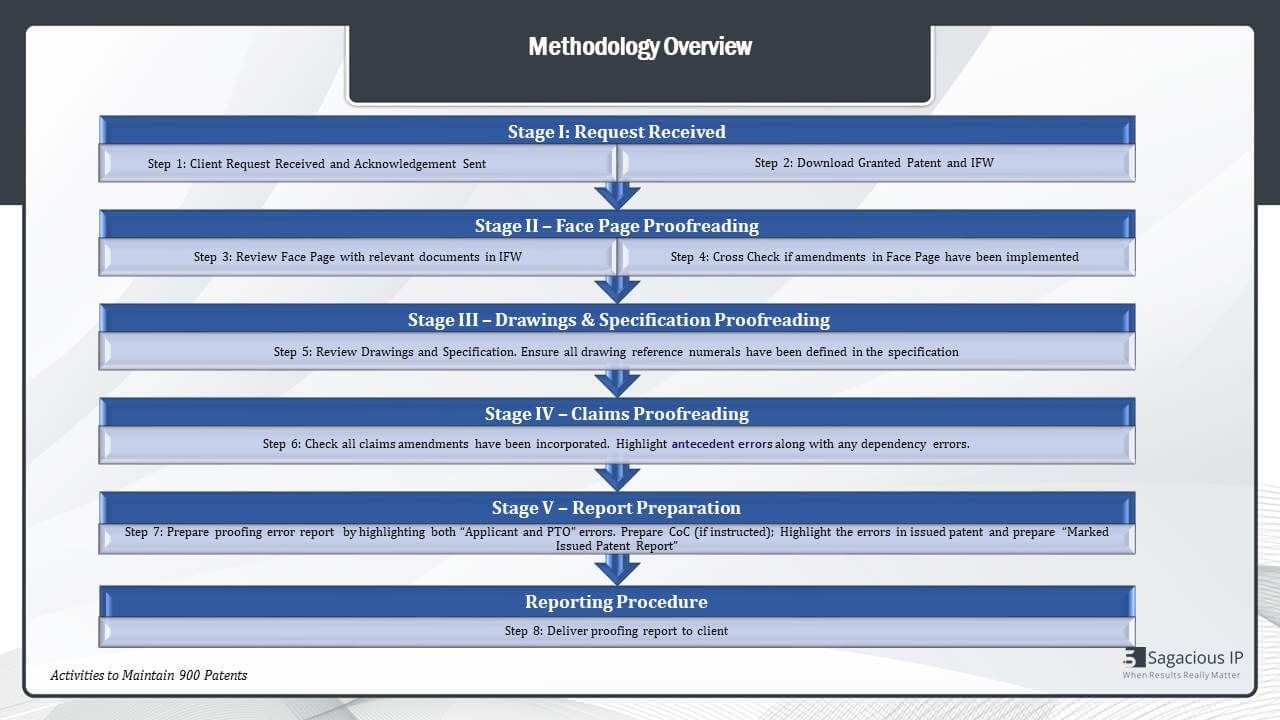
Types of Proofreading Patents
Now, proofreading patents can be of two types:
- One is whole patent proofreading that includes drawings, specification, claims, and the first page – we call it face page.
- And, the second type of proofreading would be that face page and the claims.
Based on the client’s instruction, we receive patent number, then we send acknowledgment, and we download image file wrapper from the Public Pair. First, we check all the forms which we have filed at the USPTO at the time of application filing, and we check all the information has been correctly incorporated on the first page, then we move to the drawing, and, in the drawing, again, we check if all reference numerals and a figure number and everything is in compliance with the USPTO, then we go ahead, and we do the specification proofreading, and here, also, that entire detailed procedure is being followed.
Last but not the least, it is Claim proofreading. Claim, as I mentioned and all know that claim is one of the important aspects of any patent application. Certainly, everything would be taken care of by doing the proofreading also and
And, again, once a proofreading is done, they prepare report. There would be two types of report: one is word document where we explain that under what section error has been found, and another report would be a PDF report where we would just highlight that in the granted patent – highlight under what column number and what line we found the error. So, this is the report, and, we prepare and send it to the client.
So, that’s all from my end.
Melvyn Thomas Speaking – Great! Thank you so much Samir and Prateek for this elaborative coverage. Prateek, you covered pretty much about how important it is to get the patents proofread and avoid those errors that you showed in your presentation, and Sameer thank you for letting us know how the entire process of proofreading works and what are all the important things that are required to be covered while doing the proofreading so that applicants can get patent proofreading advantages?
Questions
So, moving on to the next part, we have some questions from the audience here, and I will just pick a few questions, and then we can have this question-answer round with our presenters. Prateek, you mentioned about different perils of not proofreading the patent. Can you quickly summarize those problems for our audience here?
What are the Perils of Not Proofreading Patent?
Prateek Mohunta Speaking – Right, sure, why not?
We talked about different issues. For example, we talked about errors in the issued patent that can change the scope of the invention. We, also, talked about errors that could be there in the priority information that can cause abandonment of a patent. We, also, talked about any possibly missing or incorrectly provided-prior-art references or entries that may jeopardize the validity of a patent. I think we also talked about errors from the drawings and specification that could possibly cause problems with the enablement of the claims and can change the scope of the invention. Similarly, errors in the claims can lead to reduced or different problems with enforceability of the patent.
There are multiple errors and that we need to look at while proofreading and depending upon what the final objective may be from the client or from the customer. They can choose to look at it in a modular fashion where they can look at, maybe, when they’re getting the proofreading done.
They can look at either – just the front page review which is more on the bibliographic pointers or they could look at – just the front page and the claims if that is what they focus most on, and they want to do that page or they could look at a more detailed review in which even specifications and drawings and reviewed.
Melvyn Thomas Speaking – Right, yep, so, you’ve clearly summed that errors can occur in every section of the patent application whether it is drawing, specification, or the claims, and you’ve also told us about how it can impact the scope or, even, it can lead up to the abandonment of the patent.
So, yeah, thanks a lot for that Prateek.
How to Correct Errors in Patent Applications to get patent proofreading advantages?
Samir, you talked about how to identify errors. Could you tell us a bit about what are the ways to correct errors in the issued patents and the costs associated to it?
Sameer Kumar Speaking – Just to correct the errors, we need to file a certificate of correction highlighting the errors and that corresponding correction, right? The cost for correcting applicant errors is $150 per error, and there is no cost for PTO errors.
What’s the Time Period to File COC?
Melvyn Thomas Speaking – Okay, all right, thank you, and just a follow-up question to do this since I see it here. Is there any timeline to file the certificate of corrections?
Sameer Kumar Speaking – No, COC that is certificate of correction can be filed any time after the issuance. However, it is always better, or we always advise to the client that to get it done as soon as possible to ensure minimum impact of errors during that patent life term.
Should Patent Proofreading Be Done by Subject-Matter Expert?
Melvyn Thomas Speaking – Okay, great! Yes, I can see some more questions coming from the audience here, so, Prateek, let me shoot it to you. As per you, should a subject-matter expert do the proofreading? Or should it be done by a patent attorney? Or should it be done by both? Or would it be better if it’s done by a third party?
Prateek Mohunta Speaking – Oh! Right, a good question, but, so, it depends on what the person feels comfortable with, but our suggestion is that person, who has crafted the application, not be the person doing the proofreading. It will be better if a third party with patent-matter-related expertise does the proofreading. The person to do this should be selected based on the working – the minimum criteria that they should have is, you know, having a working knowledge of the US patent laws and the attorneys stylistic preferences in general, so that’s something that gets developed over time, but once you choose a proofreader, I think, you should stick with that person so you can maximize patent proofreading advantages.
Melvyn Thomas Speaking – Okay, so, if I understood it correctly, what you’re trying to say is that it should not be the one, the assignee or the inventor.
Prateek Mohunta Speaking– It should be the third person who has not been involved in crafting of the application, because it’s someone who has done it and the minor errors that are there. They often get missed while proofreading if, especially, you have been the person who has spent most of the time drafting it and working on it.
Is Proofreading Done for Patent Offices besides the USPTO?
Melvyn Thomas Speaking – Okay, thank you. Sameer, another question to you from the audience – you covered this in detail for the USPTO, but can this service, patent proofreading, also be done for EPO or other similar patent offices, not just the USPTO?
Sameer Kumar Speaking – Yeah! Very good question!
Thank you!
This proofreading service can also be done for EP patents and the applications from other PTO as well. So, as far as EP patent is concerned, we always advise the client to get it proofread at the time of application filing, because in EP, generally, there would not be much office action. So, if the number of an office action would be lesser, then the chances of rejection would not be very high. Therefore, in the granted patent, EP patent, so, we, generally, do not see that amendment has not been incorporated. Therefore, it is always better that for EP or other countries, English Patent should be proofread at the time of application filing.
What are the Proofreading Parameters?
Melvyn Thomas Speaking – Okay, great! Another question here to you, Sameer – what parameters do you include for proofreading patents at application filing stage?
Sameer Kumar Speaking – Since we are going to file the application and we do not have anything, on that basis, we can ensure that examiner has a proof. So, it is our responsibility to get it done at our end. So, we, generally, suggest that we will check all grammatical mistakes, we will check antecedent errors in claims, and then, again, drawings, reference numerals in drawings. Drawings have been prepared by illustration team or by drawing team as per the USPTO compliance that we check. Last but not the least, we should always check the consistency of various terms in the application to obtain patent proofreading advantages.
How Much Time It Takes to Proofread a Patent Application?
Melvyn Thomas Speaking– Okay, that sounds good. So, Prateek, a question to you – so, usually, how long does it take for somebody, for an expert, to proofread a patent? Say a normal patent with average number of pages – you can say.
Prateek Mohunta Speaking – Right, so, standard patent application, assuming about 30 pages long patent applications. I think that it would take about two days or so to actually get this done. It could be done even quicker depending on – I think that we discussed this during the webinar as well that, we could just do the face page review, we could, maybe, do the face page and claims review, or a third option or more detailed option could be that we do a face page, claims and a specifications review.
So, depending on the options chosen, if it’s just the face page and the claims, it might be good at an expert, I, could actually turn this around within a day or, maybe, two days, and a more detailed one could take maybe up to three days or two to three days. It depends on that, but, mostly, all the experts and even, for example, a company like ours would, also use a combination of a manual and an automated process to get the proofreading done so that this could turn out to be a lot faster. So, I would say, on an average, about two to three days of turnaround to proofread a patent. It could be quicker.
Is Proofreading Patents Beneficial for Both Provisional and Non-provisional Application?
Melvyn Thomas Speaking – Great! Okay, another question here. I will just read out the way it has been given to us. So, it says – are you addressing issued patents only? And another similar kind of question is: are you combining both, provisional and non-provisional patent applications, or only non-provisional patent applications?
What I assume is that they’re trying to ask if the proofreading would be done just for issued patents and then it also relates to drafted patent applications. I believe they’re trying to ask if it is done for just the non-provisional patent applications, or does it have to be done for the provisional patent applications as well?
Prateek Mohunta Speaking – Right, I think that we addressed it during the course of the webinar. It can be done at multiple stages. We, usually, advise that we provide to our client is to get it done, once, before filing of the application and, once, the notice of allowance has been received. It’s best to get it done in two stages: once at the initial filing stage and once just before the patent gets issued. So, those are the two stages that are best, and it’s the most optimal use of the effort from the proofreader. It helps and balances out the cost as well as the value of effort.
At What Stages Proofreading Should Be Done?
Melvyn Thomas Speaking – Okay, sounds good. All right, Sameer, I think that you covered this part during your presentation already like at what stages do you suggest the proofreading should be done? But we have a question related to that here. It says that why is it required for the proofreading to be done before the patent gets granted? So, can you share some light on that?
Sameer Kumar Speaking – Yes, so, before any patent gets granted, because once patent is granted, for whatever applicant error you are filing a certificate of correction, you need to pay $150 each error. Therefore, if you get it proofread before the patent is granted, or at the stage of publication, or at the stage of application filing, you are going to save all these $150 each error. Certainly, it is not going to go to the USPTO account. It will be with you. So, certainly, it’s directly related to a money saving. All applicant error will be corrected
What are the Patent Proofreading Advantages ?
Melvyn Thomas Speaking – Okay, great! So, Prateek, in your presentation, you mentioned that there’s a possibility of invalidation if, sometimes, there’s a proofreading not done in the claims part, and that’s why it is important to get a proofreading done at different intervals. I mean what we are trying to ask is: does the proofreading make sure that everything that has to be captured in the claims gets corrected if it is done on time?
Prateek Mohunta Speaking – What proofreader does is, basically, helps ensure that what the applicant wants at the end of the prosecution process. Applicant can’t really, rather, a proofreader can’t really make changes to that but he will ensure or the person who’s proofreading will ensure that the allowable subject-matter is exactly what it was allowed – what it was, and that should help the applicant get full value out of the claims that they are getting. So, yes, a good proofreader and expert proofreader will ensure that such errors which could lead to possible enablement issues and possible enforcement issues are taken care of and removed at the very beginning of the patent.
Melvyn Thomas Speaking – Okay, thanks a lot for that answer Prateek. So, yeah, this has been a wonderful session, and thank you to the speakers for enlightening us with your views and for answering the questions that came from the audience. I’m sure our listeners have great takeaways from this session, and we’ll be able to use several of these pointers when working on patents for their businesses. We have almost covered all the questions that we’ve received from the audience. There could be a few questions that might have left unanswered, but we will answer them in the write-ups when we publish, post this webinar. Participants can drop us an email at [email protected]. Our website is www.sagaciousresearch.com.
So, with this, I would want to extend a big thank you to our listeners who helped us start on time and finish on time as well. We highly appreciate you for joining the webinar “Patent Proofreading Advantages – Pains and Perils of NOT Doing Proofreading.”
Thank you again and have a great day.
Submit Your Information to watch the Webinar Video:
"*" indicates required fields


